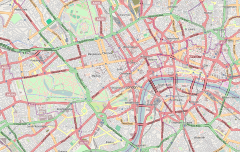York Buildings Water Tower
Appearance
| York Buildings Water Tower | |
|---|---|
 Engraving of York Buildings and the Water Tower, c. 1780, by Isaac Taylor | |
| General information | |
| Status | Demolished |
| Type | Water tower |
| Architectural style | Octagonal |
| Address | Villiers Street |
| Town or city | London |
| Country | UK |
| Coordinates | 51°30′28″N 0°07′23″W / 51.507904°N 0.123049°W |
| Completed | Late 17th century |
| Height | 70 feet (21 m) |
| Technical details | |
| Material | Wood |
The York Buildings Waterworks' Water Tower was a water tower on the north bank of the River Thames and a dominant feature of the 18th century London skyline. It was built by the York Buildings Company, who operated the waterworks there.
The water tower was a wooden structure, 70 feet (21 m) high[1] and with an octagonal cross-section. It was erected in the late 17th century on a site at the end of Villiers Street, by the York Watergate, now part of the Victoria Embankment Gardens. The Survey of London includes a drawing (plate 31[2] in volume 18[3]) showing the building.
In art
[edit]The prominent position and height of the water tower meant it appeared in many paintings and drawings of London's north bank at the time. These include:
| Artist | Title (date) | Gallery/Collection | Notes |
|---|---|---|---|
| John Boydell | Westminster and the York Buildings Waterworks | Palace of Westminster | [4] |
| Canaletto | London Seen Through an Arch of Westminster Bridge (1746–47) | Syon House | [5] |
| Canaletto | London: The Old Horse Guards from St James's Park | Tate Gallery L02305 from The Andrew Lloyd Webber Foundation | [6] |
| Canaletto | "The Thames at Westminster, London" | National Trust, Penrhyn Castle | [7] |
| Joseph Farington | The Old Water Tower at York Buildings, Whitehall | Victoria and Albert Museum | |
| James Peller Malcolm | York Buildings looking towards Westminster with a View of the Water Tower | [8] | |
| James Malton | The River Thames Looking Towards Westminster with York Water Gate and the York Building Water Works (1797) | Tyne & Wear Archives & Museums | [9] |
| William Marlow | The London Riverfront from Westminster to the Adelphi (1971–72) | Museum of London | [10] |
| Samuel Scott | An Arch of Westminster Bridge (c.1750) | Tate Gallery T01193 | [11] |
| Samuel Scott | An Arch of Old Westminster Bridge (c.1750) | Tate Gallery N01223 | [12] |
| After Samuel Scott | A View of the Thames with the York Buildings Water Tower | Tate Gallery N01328 | [13] |
| After Samuel Scott | The Thames with the York Buildings Water Tower | National Museums Liverpool, Walker Art Gallery | [14] |
References
[edit]- ^ "British Library Collection". British Library. Retrieved 21 September 2013.
- ^ G. H. Gater and E. P. Wheeler (1937). Survey of London: volume 18: St Martin-in-the-Fields II: The Strand. Institute of Historical Research. pp. 19–21. Retrieved 21 September 2013.
- ^ G. H. Gater and E. P. Wheeler (1937). Survey of London: volume 18: St Martin-in-the-Fields II: The Strand Plate 31. Institute of Historical Research. pp. 19–21. Retrieved 21 September 2013.
- ^ "Boydell". Art UK. Retrieved 15 September 2013.
- ^ "Canaletto". WikiPaintings. Retrieved 16 September 2013.
- ^ "L02305". Tate Gallery. Retrieved 15 September 2013.
- ^ "Canaletto". Art UK. Retrieved 16 September 2013.
- ^ "Malcolm". WikiGallery. Retrieved 16 September 2013.
- ^ "Malton". Tyne & Wear Museums. Archived from the original on 16 October 2013. Retrieved 16 September 2013.
- ^ "Marlow". Art UK. Retrieved 15 September 2013.
- ^ "T01193". Tate Gallery. Retrieved 15 September 2013.
- ^ "N01223". Tate Gallery. Retrieved 15 September 2013.
- ^ "N01328". Tate Gallery. Retrieved 15 September 2013.
- ^ "Scott". Art UK. Retrieved 15 September 2013.

